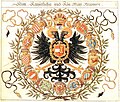Fichier:Wappen röm.kaiser.JPG

Taille de cet aperçu : 707 × 599 pixels. Autres résolutions : 283 × 240 pixels | 566 × 480 pixels | 920 × 780 pixels.
Fichier d’origine (920 × 780 pixels, taille du fichier : 279 kio, type MIME : image/jpeg)
Historique du fichier
Cliquer sur une date et heure pour voir le fichier tel qu'il était à ce moment-là.
| Date et heure | Vignette | Dimensions | Utilisateur | Commentaire | |
|---|---|---|---|---|---|
| actuel | 14 octobre 2005 à 23:18 |  | 920 × 780 (279 kio) | Finanzer | * Technisch nachbearbeitet von wolpertinger |
| 31 août 2005 à 22:38 |  | 998 × 846 (171 kio) | Fb78 | '''Description''' Wappen der Kaiser des Heiligen Römischen Reiches Deutscher Nation '''Source:''' Wappenbuch von Johann Siebmacher, 1605 Uploaded by de:Benutzer:Hansele |
Utilisation du fichier
Les 8 pages suivantes utilisent ce fichier :
Usage global du fichier
Les autres wikis suivants utilisent ce fichier :
- Utilisation sur an.wikipedia.org
- Utilisation sur ar.wikipedia.org
- ليوبولد الثاني (إمبراطور روماني مقدس)
- هابسبورغ
- فرديناند الأول (إمبراطور روماني مقدس)
- فيتلسباخ
- بالاتينات الانتخابية
- ألكسندر براون
- دوقية براونشفايغ لونيبورغ
- اتحاد شمالكالدي
- اجتماع شباير الثاني
- دوقية لورين
- أرنولف الكارينثي
- إمارة بايرويت
- إمارة أنسباخ
- لاندغريفية هسن دارمشتات
- ساكس فايمار
- دوقية ساكسونيا هيلدبورغهاوزن
- دوقية ساكسونيا غوتا ألتنبورغ
- دوقية ساكسونيا كوبورغ زالفلد
- دوقية أولدنبورغ
- انتخابية هسن
- لورين المنخفضة
- الأقاليم السبعة عشر
- خيلدرز
- بوابة:الإمبراطورية النمساوية/مقالة مختارة
- بوابة:الإمبراطورية النمساوية/مقالة مختارة/2
- بوابة:الإمبراطورية النمساوية
- بوابة:الإمبراطورية النمساوية/مقالة مختارة/أرشيف
- ليوبولد موتسارت
- موريتس بالتازار بوركهاوزن
- كونتية أرتوا
- الأراضي المنخفضة النمساوية
- فريدريش ألبرخت أنطون ماير
- يوري فيغا
- غابرييل غروبر
- ألبرت الرابع، دوق النمسا
- الأرشيدوقة ماريا آنا من النمسا (1610-1665)
- فيلهلم فريديمان باخ
- البرلمان الامبراطوري
- ليوبولد الرابع دوق النمسا
- يوهان كاسبار فون ستاديون
- معاهدة جيرستنجن
- سلام نيكولسبورغ
- معاهدة السلام في جميع أنحاء العالم المسيحي
- دوقية بوهيميا
- رودولف الثاني كونت هابسبورغ
- ألبرخت الرابع كونت هابسبورغ
- قالب:بذرة أعلام الإمبراطورية الرومانية المقدسة
- قالب:بذرة طبيب روماني مقدس
- قالب:بذرة كيميائي روماني مقدس
Voir davantage sur l’utilisation globale de ce fichier.
